Equinox 120ED
Skywatcher Equinox 120mm ED Apochromatic refractor - By Antony McEwan
I’m very happy with my Skywatcher ED100 Pro: 100mm of apochromatic unobscured aperture, operating at f9, with a nice aftermarket Baader rotatable Crayford focuser added by me after purchase. Stunning views of planets, Moon and deep sky objects (up to a point for the last type of target), and relatively lightweight. So did I really need to add a 120mm version to my collection? Well, I’d been reading such good things about the Equinox 120ED since it was launched, and it seemed to combine an increase in aperture with a similar level of optical quality to the 100ED but without an increase in focal length. It sounded too good to be true.
The Equinox doublet contains the same element of FPL-53 synthetic Flourite as the objective doublet in the previous incarnation of Skywatcher Pro ‘scopes, but it is installed in a much classier tube assembly. For a start, it’s not painted champagne gold, which is probably a plus in anyone’s book. It comes in a very nicely finished shiny black tube with silver trim, an extending dew-shield, rotatable 2” two-speed Crayford focuser, finished off with chunky secure CNC style tube rings and a dovetail plate, all shipped in an aluminium carry case. The price for all these improvements? Just into four figures. Now the last time I spent four figures on a ‘scope, it was to buy a small ‘premium’ Apo - a TeleVue 85 - several years ago. So would the same approximate outlay buy 120mm of decent quality apochromatic aperture in a nice tube, made by a renowned budget equipment manufacturer? I decided to find out…
Little Worries
Despite my optimistic outlook, I did have some concerns:
- Would the telescope operate acceptably at f7.5, and still give views free of false colour? After all, my ED100 does a good job, but is f9 – quite a difference.
- How heavy will it be? Would my trusty old Vixen GP handle the extra weight?
- Would that rotatable dual-speed focuser operate as nicely as the Baader one I added to the ED100, or will I still have to add a third party replacement, taking the price up a notch?
So, to make the purchase work I had to resolve to be particularly judgmental on the optical quality and the mechanical quality to see if it was indeed an overall improvement over the trusty ED100. Also, if the GP didn’t handle it well, it would not be staying.
The reason I was tempted in the first place was that many reports on the Internet stated that the views yielded greater resolution than the ED100 (because of the larger aperture) but did not yield any greater amount of false colour. Now, some people say the ED100 is colour-free, and others will say that there is some there when viewing bright objects. Personally, I’ve never seen any when the image is in focus. The same was said about the TeleVue 85 apparently, but I only saw the tiniest amount in that ‘scope, and even then only on the limb of a brightly lit Moon. As always, curiosity played a large part too.
Big Brown Box
Eventually, the big brown box arrived. It opened to reveal an aluminium case, just slightly shorter than the one which housed my ED100, wrapped in bubble wrap. The case (or rather the combined weight of the case and the contents) was heavy! The case also sported a dent at one end, and the finish of the aluminium texture was not completely even, as it showed some bubbles at various places on the top. Still, it was the contents that concerned me most at that point.
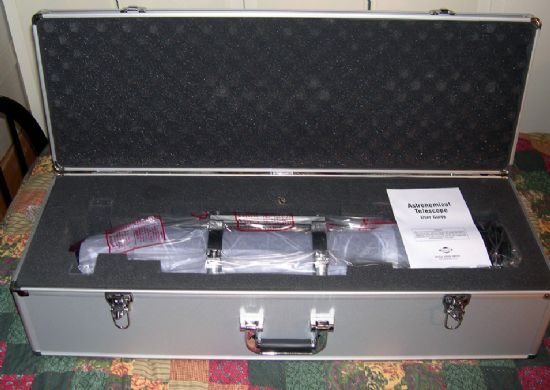
Opening the case revealed something black and shiny. It was hard to make out as it was wrapped in white tissue paper, and placed inside a clear plastic bag. It was all a very snug fit in the case’s foam-lined interior – very professional looking. I carefully lifted it out, unwrapped the bag and removed the tissue. Very shiny. Very black. Very smooth. Very even paint application. The silver trim around the rear edge of the sliding dew-shield and the front of the focuser were very tasteful and understated. I was very impressed. The tube is noticeably heavier than the ED100, but it is quite compact and not much larger overall than the 100mm model. Luckily, I just happened to have my Vixen GP mount all set up so I immediately mounted the tube onto it and tightened it all in place.
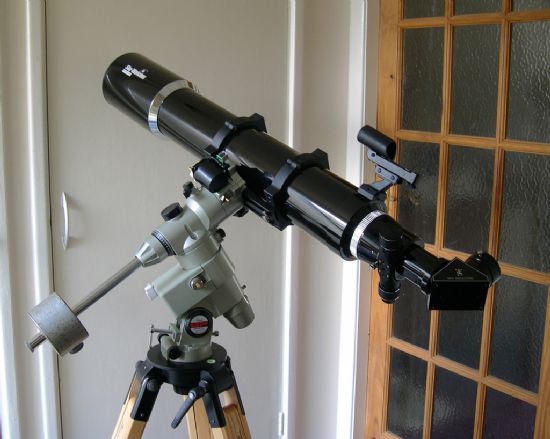
Wow!
This was one sharp looking set-up!
Concerned about the ability of the mount to hold such a beast, I kept prodding it to see if it wobbled at all, but no wobbles were to be seen. (Mind you, the GP is mounted on an ash Berlebach UNI-18 tripod, a very stable lump of wood for telescope mounts). I had removed the slip-on aperture cap and extended the dew-shield by simply sliding it out until it clicked into place. The movement was smooth but not too easy. Just perfect. Extending the shield altered the centre of balance, so I inserted the 2” diagonal and an eyepiece, and the ‘scope was once again balanced on the mount’s axes. I did have to extend the counterweight along the counterweight shaft to balance it in Right Ascension, but this was easily done.
I had a look at the objective – the business end. Very nice green multi-coatings were evenly applied over the glass. There were no intrusions into the light path from anything like spacers or screws inside the tube. The interior was very, very dark – much darker than on my other Skywatcher ‘scopes. So far so good – I was still impressed.
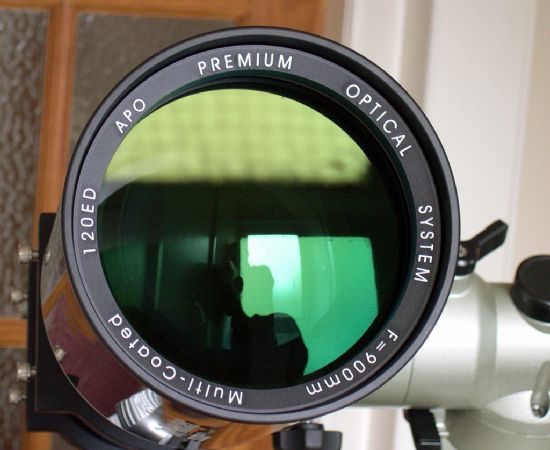
I had a go at playing with the focuser. There are two large focus knobs, one on each side. Projecting out beyond the right hand knob is a smaller version. Turning either large (coarse) knob moved the drawtube in or out at a normal rate of speed. Turning the smaller (fine) knob resulted in the drawtube being moved by a much smaller amount. It is a geared reduction unit that reduces the amount of motion per turn by a ratio of 11:1, resulting in very fine focus. This is very useful when focusing on precise planetary details or when trying to pinpoint the absolute perfect focus position. The faster the focal ratio of the ‘scope, the more useful this feature is, as the depth of focus diminishes as the focal ratio decreases; a very useful feature for an f7.5 ‘scope. There is a knurled focus-lock knob too, which locks the focuser position in place. Again, handy for astrophotography or for making sure that the focus position doesn't change between views. There is also a recessed allen-bolt that adjusts the tension on the focuser. One thing that did detract though was the fact that while the fine focus knob rotated perfectly smoothly, the coarse focus felt a little bit… not quite ‘rough’, but… lumpy. It was not equally smooth at every point in its motion. I noted it and resolved not to let it slip by me.
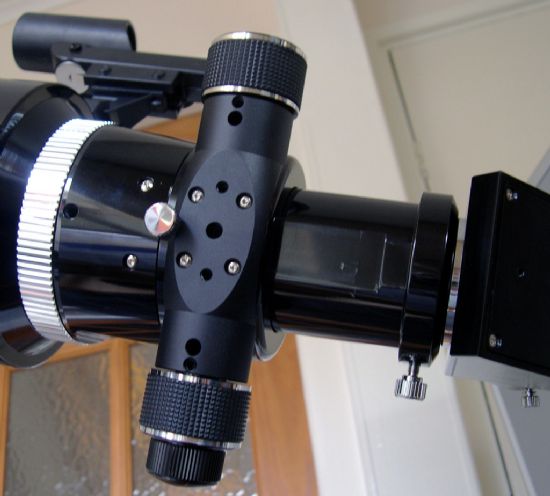
Another focuser feature is the ability to rotate it about the axis of the optical tube assembly, so as to place the diagonal and eyepiece in a more convenient position for viewing. This is very handy when using the ‘scope on an equatorial mount. Also, if you are inclined to practice the dark art of astrophotgraphy, it is useful to align the camera/sensor so as to orient and frame the subject nicely. When I loosened the locking collett to rotate the focuser body, it screeched at me. Yes, it really screeched. It was the screech of dry unlubricated metal moving against dry unlubricated metal and was not very pleasant. Also, when I had repositioned the focuser body and retightened the locking collett, it was hard to tell if it was securely locked in place. In fact, it was still moveable, so I had to tighten it up some more. This meant that when I tried to loosen it again, it was very hard to do so, and when the collett finally did unlock, it resulted in some more screeching, just for good measure.
First and Second Lights
Just to recap, in order for the Equinox to be a success it had to show an improved view of everything when compared with the ED100. It had to show the same amount of false colour (none, to my eyes), had to be carried easily by the Vixen GP, and everything mechanical had to be good as well. Bit of a tall order? Maybe, but I was quietly optimistic. Amazingly, First Light was achieved only a couple of nights after arrival…
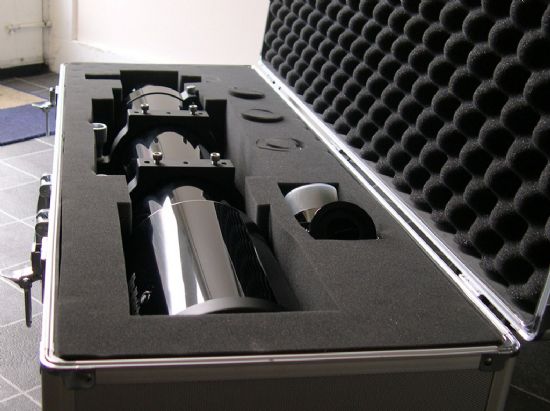 It took place on 28th Nov, a night with no Moon present. The sky was clear and seeing was very good. I set up the GP and installed and balanced the Equinox on it. During the polar alignment procedure, I racked the focus in and out a few times and studied the diffraction rings. They were perfectly circular, completely concentric and smooth-edged. I took this to be a good sign. Although I was not performing a dedicated star test as such, I did notice that when Polaris was perfectly focused there did not appear to be any false colour. Mind you, I was only using 64x magnification so this wasn’t a harsh test. Naturally, Polaris’s companion star was easily visible, even at only 28x as well!
It took place on 28th Nov, a night with no Moon present. The sky was clear and seeing was very good. I set up the GP and installed and balanced the Equinox on it. During the polar alignment procedure, I racked the focus in and out a few times and studied the diffraction rings. They were perfectly circular, completely concentric and smooth-edged. I took this to be a good sign. Although I was not performing a dedicated star test as such, I did notice that when Polaris was perfectly focused there did not appear to be any false colour. Mind you, I was only using 64x magnification so this wasn’t a harsh test. Naturally, Polaris’s companion star was easily visible, even at only 28x as well!
First target was M57, the Ring Nebula. Easily distinguishable at 64x, but with no real detail in the ring structure. Stars sharp across the field of view. A pleasing, if hardly challenging, start.
Second target was Alberio in Cygnus, a beautiful double star with contrasting orange and blue components. I upped the power to 134x and tested the fine focus. It was very nice indeed, allowing me to get the stars absolutely perfectly focused. I noticed that there was no mount jiggle when using the fine focus. Even when using the coarse focus, there was hardly any at all.
Next I tried to split Epsilon Lyrae, the double double. It did not split easily, even at 134x. It was low in the sky though, and I attributed its components’ unwillingness to separate to that!
I changed down a gear, and inserted the Pentax XW30 eyepiece. My only 2” eyepiece (at the 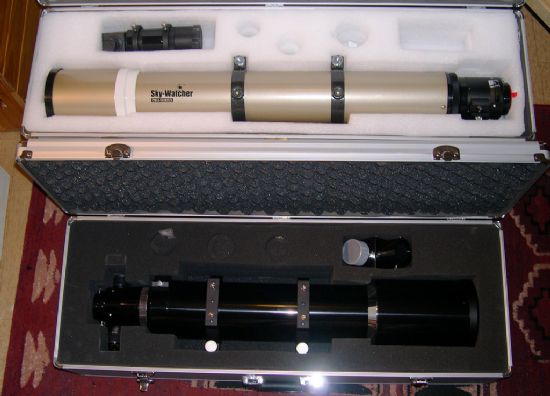 moment) it has a 70 degree apparent field of view, which translates to 30x magnification and a ‘true’ field of view of 2.33 degrees. I swung over to the Andromeda galaxy and its satellite galaxies, M32 and M110. Best view ever? Quite possibly. The detail within M31 itself was noticeable, and especially so because I was only using 120mm of aperture. I’ve seen it show more detail, but only in much larger ‘scopes. It certainly surpassed recent views through the ED100 by a long shot, and that is not shabby on the galactic trio in its own right.
moment) it has a 70 degree apparent field of view, which translates to 30x magnification and a ‘true’ field of view of 2.33 degrees. I swung over to the Andromeda galaxy and its satellite galaxies, M32 and M110. Best view ever? Quite possibly. The detail within M31 itself was noticeable, and especially so because I was only using 120mm of aperture. I’ve seen it show more detail, but only in much larger ‘scopes. It certainly surpassed recent views through the ED100 by a long shot, and that is not shabby on the galactic trio in its own right.
But the best view of the night came when I panned over to the Pleiades. I've looked at M45 in many scopes with many eyepieces over several years, and the view that I had through the Equinox was the BEST EVER. It was jaw-droppingly stunning. The entire cluster framed within the field of view, and the nebulosity was not just one or two small sections; it was everywhere you see it in the photographs. Absolutely one of the best views I've ever had. At that moment I would have kept the ‘scope simply to look at the Pleiades every clear night.
I couldn’t pass on M42, the Great Orion Nebula though, and just as an aside, winter is the absolute best season for buying new telescopes! There’s just so much good stuff to look at with them! I used the Pentax XW30 again and the view was amazing! The trapezium was easily split into 4 components at only 30x, and the nebulosity filled the field, along with several of the other highlights of the Orion's Sword area. Increasing the power to 64x revealed the E component in the Trap; and it stayed there - solid and easy to see. I wanted to carry on hunting for F but my drive batteries failed, so I had to pack up...
…until Second Light, the very next night! M27, the Dumbbell Nebula was observed, but it was quite low in the sky so I wasn’t expecting much. For a proper visual treat I looked at Mizar / Alcor in the Plough. The four main components were all easily divided at low power, and shone bright and white – a textbook view. Inspired by that success, I re-tried the double double, Epsilon Lyrae. It was much more pleasing this time around, with steadier seeing, easily discernible darkness between the stars, and individual diffraction rings around each tiny component! Lovely!
As a galaxy taster for the night, M81 and M82 were hunted down and they shared the field of view at 64x in the Pentax XL14. A very nice image, with some amount of detail seen in each galaxy.
Finally, I had a go at splitting Rigel in Orion. The magnitude 0.1 white supergiant has a much dimmer 7th magnitude companion, quite close to the primary, and the difference in brightness at such a narrow separation makes it a challenging double - unless you’re using an Equinox 120ED, that is. I mean, ok, I’ve split it in the TeleVue 85, the ED80, and the ED100 as well, but it was just so EASY in the Equinox. It felt like cheating…
Now the views were absolutely stunning, and I was rapidly considering having the ‘scope surgically attached so that I need never be parted from it again, but it was not exactly perfect. Remember the focuser issues I mentioned? The rotation screeching was getting on my nerves, and the coarse focus was too bumpy for my tastes, especially when compared with the Baader unit on my ED100. The thing is, when turning the coarse focus knob, there was an amount of what can only be described as ‘stiction’ that was unpleasant. I define ‘stiction’ as an amount of friction, or stick, that has to be overcome before motion occurs. Dobsonian users are familiar with it, as it applies to the amount of resistance the azimuth or altitude bearings have on their rocker boxes. Less stiction = easier to get moving = smoother overall motion. My coarse focus knob was encountering too much stiction. If I wanted to keep the ‘scope and defend my decision I had to do something about it.
The Quick Fix
I always like to make the most of what I have, before throwing money at a problem. So, I had a good close look at the focuser itself. It simply unscrews completely from the telescope body. A 1cm wide male threaded section juts out from the OTA and the interior of the locking collett on the focuser is threaded too. This is how the focuser is attached to the OTA. The collett is captive to the focuser body, and there is a small grub screw that allows the collett to be unscrewed from the focuser slightly. I did this, and once the focuser was removed I could see that all the threaded parts were completely devoid of any lubricant at all. Whether or not this was intentional, I don’t know, but I strongly suspected that application of a small amount of lithium grease would smooth things along. I applied the bare minimum to coat the threads, both on the male extension from the OTA, and to the inside of the threaded collett, using a small pin dipped in the grease. Once it was all reassembled, the grease had spread to the areas it was needed, and suddenly the focuser rotation was perfectly smooth, much easier, more definite – and silent! A minor victory!
Adjusting the action of the coarse focus wheel was a little more effort. It required lots of fiddling and adjustment of various screws and fittings, and in the end the improvement was only marginal. It was certainly no worse than before I started, but was not what I think of as an unqualified success. But then, I admit I am quite picky about focusers. I got to test the ‘tweaked’ unit on a couple of occasions, when I had the chance to try the Equinox out as a lunar ‘scope.
Dancing in the Moonlight
I wanted to know how good the Equinox would be at revealing lunar features. The ED100 is excellent at this, and gives a pure, almost stark, view of the Moon, uninhibited by false colour, and capable of soaking up high magnifications to zoom into the details.
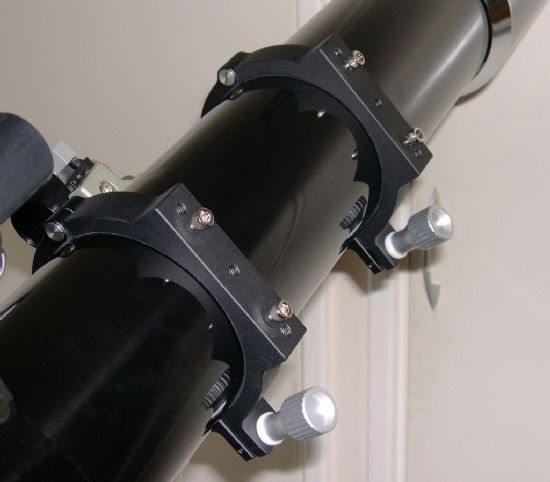 The first night I sampled the Moon through the 120, the seeing was above average but not great. I used a variety of eyepieces and scanned the terminator, viewing the sunken crater shadows and prominent mountain peaks that projected into sunlight from hidden dark depths. It was excellent. The focus was nice and sharp, the detail was very enticing; simply begging me to use higher and higher magnifications, though the seeing limited me to 173x maximum. Any higher and the atmospheric distortion was too bad to yield a smooth image. I did not notice any false colour on this occasion.
The first night I sampled the Moon through the 120, the seeing was above average but not great. I used a variety of eyepieces and scanned the terminator, viewing the sunken crater shadows and prominent mountain peaks that projected into sunlight from hidden dark depths. It was excellent. The focus was nice and sharp, the detail was very enticing; simply begging me to use higher and higher magnifications, though the seeing limited me to 173x maximum. Any higher and the atmospheric distortion was too bad to yield a smooth image. I did not notice any false colour on this occasion.
The second night of Moon viewing was the 10th Dec, two nights before Full Moon. The seeing was much better, almost perfect. Unfortunately, I was set up in my back garden, on paving stones, and the tiny amount of vibration from my mount’s motor drive showed itself in the view. If I had been set up on grass this would not have been a problem.
Nevertheless, I set about looking for the challenging ‘Plato Craterlets’ – a series of small craters on the floor of the larger crater Plato. There are four larger ones, well within the reach of 4-6” telescopes on good nights, and several more even smaller ones that are really challenging, or require larger apertures. I was able to detect two easily, with a hint of a third, at 134x. Increasing the magnification to 173x I could confirm three in detail, sharply resolved, and a fourth was visible as a slightly less sharp area close to the third craterlet. I was seeing ‘A’, ‘B’ and ‘C’ sharply, and getting a strong impression of ‘D’ – known collectively and somewhat colloquially as ‘The Big Four’! I was impressed. Very impressed.
Thrilled as I was by this test of detail resolution, I did also notice something a little less pleasant. False colour. A tiny hint, off axis, against the lunar limb. It was at high-ish power (173x) and it showed as a slight yellow tint around the very edge of the sunlit limb. Not bad at all, but detectable when I looked for it. In craters that were on the terminator, and very close to the edge of field of the eyepiece, there was a tiny hint of purple against the very edge of the crater walls. Again, it was right at the edge of the field, and was not obvious unless being looked for, but it was there.
So I considered it and what it meant for the lunar viewing I had experienced. I had seen detail on the Moon that I had not been able to see through my telescopes before, had enjoyed the experience, and had revelled at the wonderful vistas that were revealed when I used my high-ish power wide-field eyepieces (Meade 6.7mm UWA and Pentax 5.2mm XL). The only downside was a tiny amount of false colour that was situated well off axis and did not detract from the details I had been examining in the centre of the field. I accepted the hit and honestly felt that it was so minor that I would not obsess about it, but would merely accept that it’s there (on occasion) and concentrate on the good things in the eyepiece instead.
However, on a later occasion when I observed the Moon under similar circumstances in my well-collimated 8” Dobsonian reflector- the colour was there too! In fact, it was virtually identical in position and severity as in the ED120. Conclusion: the eyepieces or the conditions were the culprits. Therefore, I have to consider the ‘false colour’ that I was seeing in the ‘scope as…’false’.
But… the tweaked focuser had been only acceptable, not great. Certainly for most people it would possibly be fine, but I was irked by the occasional ‘bump’ in the coarse focus movement and the occasional worry that the focuser lifting ability was not capable of holding my heavy diagonal and eyepieces securely in place. Nothing ever slipped, but it was always at the back of my mind.
The only long-term fix that seemed to fit the bill for me was to order a replacement focuser by Moonlite, which would be a thing of beauty and operate perfectly smoothly right out of the box and would continue to do so until Hades suffered an Ice-age. The optics seemed to deserve it, so I placed the order.
Final Verdict
I’ll update this report when the Moonlite focuser has arrived, been fitted, and tested. I’m pretty sure that the whole ‘scope will then be something I can call a ‘premium’ telescope. As it is, the focuser is the only thing that lets the package down. This is not something new – it’s happened before on Skywatcher telescopes. Also, I am not saying that every Equinox 120 will have the same focuser issues that mine did. In fact, going by posts on several astronomical forums, it seems mine is, if anything, the odd one out! If my focuser had been as good as those on other Equinox 120ED’s I have read about, I would have been very happy to keep the ‘scope in its original condition and would still call it ‘premium’.
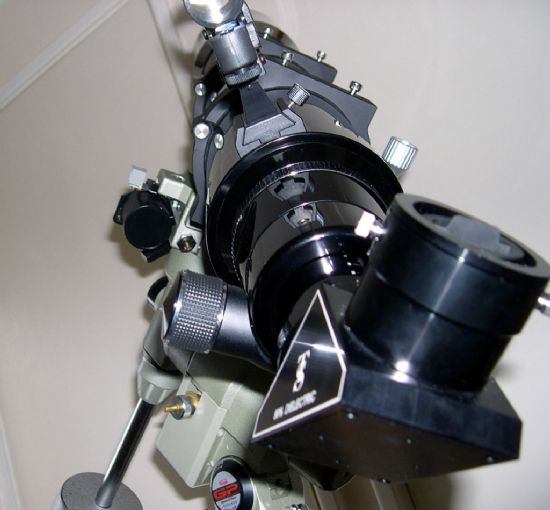
The optics are excellent. The weight is quite manageable by a medium sized equatorial mount. The quality of the build and finishing is very good indeed. The design is tasteful. Visually, it oozes class, and this is a very good move for the Skywatcher brand. The Equinox 120 is definitely the top dog in the SW line-up, and the 120mm has got to be the best choice for visual observers within the Equinox range.
Now, where has Jupiter gone…
22/03/09 Moonlite Focuser Update
As promised, here is the update regarding the Moonlite CF2 focuser. The new focuser is a two-speed Crayford with 2" drawtube and is also rotatable through 360 degrees. The similarities between it and the originbal Skywatcher one end there! The Moonlite is heavier, so adds some weight to the back end of the tube, making it slightly easier to balance on the mount and moving the tube forwards in the dovetail. It is clearly a precision instrument, with a smoothness that defies description, especially compared with the Skywatcher model. It will hold a weight of 4lb when pointing vertically with no slip (claimed by manufacturer) but can be adjusted to hold even greater weights. The fine focus and coarse focus knobs are incredibly smooth and responsive, and to top it all off it was really easy to install as well.
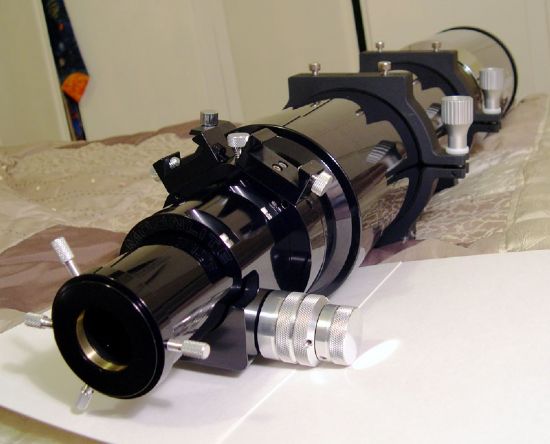
It just screwed onto the threaded section of the telescope tube, and that was it. Collimation was checked on Polaris the next clear night and showed to be perfect, so no adjustments were required for that (although there are adjustment bolts to allow that to be modified if necessary). The focuser also has two built-in finderscope slots so that you can mount an optical finder and a red dot one, for example, or a Telrad and optical finder, or any other combination! Indeed, with the tube itself also having a slot built-in, I could actually mount three finders on the Equinox.
Performance is exemplary. Nothing to fault at all, and everything to praise. Nice and easy to find perfect focus when viewing Saturn at 460x and you can't really get much better than that. I now consider my Equinox 120ED to be complete.